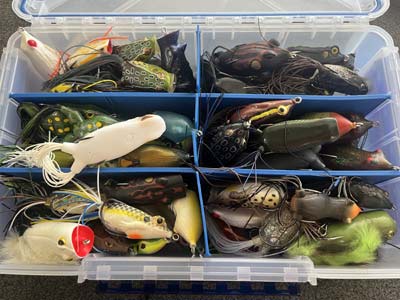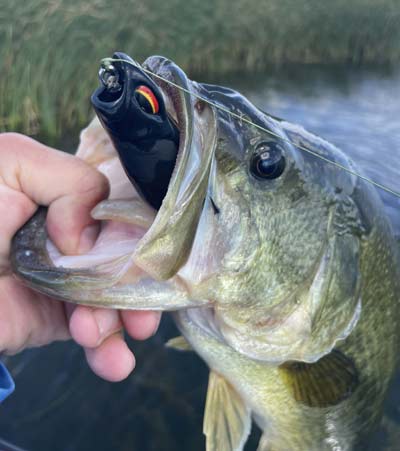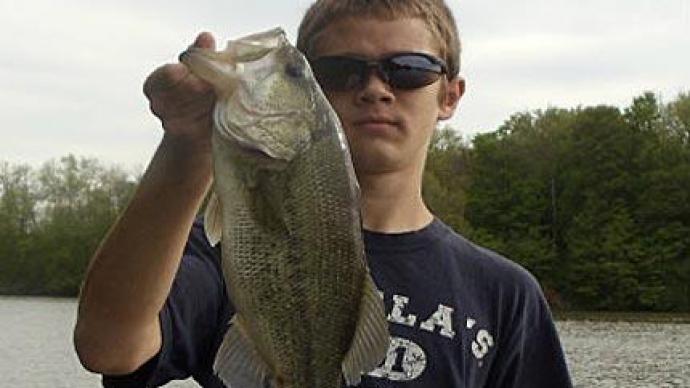
Fishing with a topwater frog is undoubtedly one of the most exciting ways to catch a bass. The highly visual and vicious strikes are some of the most heart-thumping actions you can have while fishing. As the technique has evolved and become more popular, a dizzying array of frogs is now available.
While they all look pretty similar, brands have some significant differences. Not all frogs are created equal; picking the right frog will give you more bites and help you land more. Here are five things to consider when purchasing your next frog and some insight on the best fishing gear.
-
Popping vs. Walking
When picking your next frog, consider the type best for your needs and where you are fishing. A standard frog can walk from side to side and has excellent action along the surface. It can also be used with a straight retrieve, bumping the tops of grass and hopping like a real frog.
Popping frogs, on the other hand, will create much more commotion on the surface. They are great for calling fish from longer distances and fishing for bass feeding on bluegill. Having a few of each style on hand is a good idea.
-
Softness Is Critical At Times
Image
Some frogs, like the 6th Sense Vega, have slightly longer bodies and help aid with walking a frog. One of the best ways to ensure that you hook more fish is to pick a frog with a softer material. It allows the bait to collapse and expose the hook, thus hooking a better percentage of bass.
In the old days, anglers would put their frogs in boiling water to help soften them a little bit. This trick still works, but thankfully companies have caught on, and some very soft frogs are on the market. One of the best, which also won't break the bank, is the Booyah Pad Crasher. It’s a solid frog that does everything you will need and will catch fish.
The one downside to a softer frog is that the same reason they hook more fish, the hook being exposed easier, is the same thing that will cause it to snag more. A softer frog is fine for fishing open water, but a slightly firmer frog will be a better option if you find yourself fishing them around docks, laydowns, and bushes. While you may lose some hooking power, you’ll save yourself some frustration with fewer snags. It’s a good idea to have a few different frogs on hand with extra pliability just to be sure you are ready for anything.
-
Picking The Right Rod and Reel
With much frog fishing taking place around thick grass, many anglers automatically assume they need a hefty rod to fish them. It helps when muscling a bass wrapped inside grass, but it can also hamper your ability to fish the frog correctly.
All rod manufacturers vary slightly in how "heavy" their heavy rods are, but this power is a good starting point for fishing frogs. For more open-water fishing, or when you want to walk a frog, a medium-heavy power may be all you need to fish frogs correctly, as the softer tip will allow you to work the baits better.
Image
The right rod and reel will allow you to work a frog correctly and also aid with pulling fish from thick cover. For reels, a faster reel speed is a plus. It allows you to take up line quickly if you have slack in your line and will also let you quickly get a bait back in if you see movement in the water or a blow-up on the surface.
-
Frog Fishing Line: Braid Is A Must
Technically, you could fish a frog on any line, but you'll want to use a braided line. It helps with strength for getting fish in the boat, but the no-stretch properties will also help with working the bait correctly and getting a solid hookset.
The other thing to consider is the pound test and type of braid. Some anglers like to go ultra-heavy with 65-pound braid, but using a 50-pound test will help with casting distance.
Braids come in various kinds, with the number of strands or “carriers” often mentioned. Seaguar, for instance, has an 8-strand braid called Smackdown that is very smooth and easy to cast. They also have a 4-strand braid called TactX that feels rougher but acts like a serrated knife as it cuts through vegetation. Both will do the job; it just comes down to picking the proper braid for how you are fishing.
-
Frog Modifications
Image
Having the right line and gear will allow you to land big bass with a frog Most frogs come ready to fish right out of the package, but you can make a few easy tweaks to improve how they fish. Three of the most common are trimming the legs, bending the hooks slightly, and adding rattles.
By trimming the skirted legs, you can get a better walking action from your frog. It’s a simple way to improve the performance of your frog and make it a little more compact at the same time. Similar to using a soft frog, slightly bending out your hooks will increase your hookups. The downside is that they will snag more objects. The final modification would be adding glass worm rattles or craft bells inside the frog. Just insert them into the opening where the hooks come out on the belly of the frog. The added sound will help the bass find your lure
Frog fishing is a very exciting way to fish, and you always have the chance to catch a big bass. Having success with frogs comes down to having the right gear, picking the perfect frog for the situation, and making adjustments where needed to improve your bait's performance.
BassResource may receive a portion of revenues if you make a purchase using a link above.




